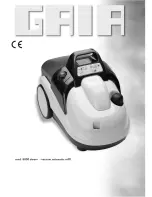
page 15 of 51
Documents are only to be used and distributed completely and unchanged. It is strictly the users´ responsibility to check carefully
the validity of this document with respect to his product. manual-no.: 999073 / 15/12/2009
cooling water inlet
(hose nozzle Ø 6 mm)
cooling water outlet
(hose nozzle Ø 6 mm)
outlet port (gas!)
(hose nozzle Ø 10 mm)
Prior to use:
☞
Max. ambient temperature
: 40 °C
☞
Make sure ventilation is adequate if pump is installed in a housing or if ambient tem-
perature is elevated. Keep a distance of min. 20 cm between fans and ambient parts.
☞
Check fan cover (underside pump motor) regularly for dust/dirt. Clean if necessary.
☞
If pump is installed in altitudes of more than 1000 m above mean sea level check
compatibility with applicable safety requirements, e. g. IEC 60034 (motor may over-
heat due to insufficient cooling).
☞
If the gas ballast valve is open, a power failure may cause accidental ventilation of
the pump. In case this constitutes a potential source of danger, take appropriate
safety measures.
☞
When assembling, ensure
vacuum-tightness
. After assembly, check the complete
system for leaks.
☞
If toxic media or media harmful to health are pumped, connect an exhaust pipeline
at the outlet and/or dispose of the exhaust gases accordingly (hood).
Installing in a vacuum system:
☞
Avoid throttling losses by using connecting pipes with large diameter and keep
them as short as possible.
☞
Reduce the transmission of vibrations and prevent mechanical loading due to rigid
pipelines. Insert elastic hoses or flexible elements as couplings between the pump
and rigid pipes.
Attention:
Flexible elements tend to shrink when evacuated!
☞
Use a suitable valve to isolate the pump from the vacuum system to allow the
pump to warm up before condensable vapours are pumped or to clean the pump
before it is switched off.
Exhaust waste vapour condenser:
➨
Assemble hose nozzles for coolant inlet and coolant outlet
pipelines at the exhaust waste vapour condenser.
The
exhaust waste vapour condenser
enables an efficient
condensation of the pumped vapours at the outlet.
☞
No backflow of condensates.
☞
Controlled recovery of condensates.
☞
Next to 100% solvent recovery.
☞
The isolation cover protects against glass splinters in case
of breaking, acts as thermal isolation to avoid condensation
of humidity and is intended to absorb shocks.
➨
Attach the pipelines of the coolant circuit to the respective hose nozzles (see im-
age) at the waste vapour condenser. Check hose connections prior to starting op-
eration of the cooling system.
➨
Attention: Install hoses of the cooling system in a way to avoid flow / dropping of
condensed water to the pumping unit (especially cables and electronic parts).
☞
Secure coolant hoses at the hose nozzles (e.g. with hose clip) to prevent their
accidental slipping.
☞
Install an optional
coolant valve
always
only in the inlet line
of the exhaust waste
vapour condenser.
☞
Ensure that the
coolant outlet pipeline
is always free and that it cannot get blocked.
☞
The gas outlet (hose nozzle 10 mm) must not be blocked. The exhaust pipeline has
always to be free and pressureless to enable an unhindered discharge of gases.
☞
Connect the exhaust to a suitable treatment plant to prevent the discharge of dan-
gerous gases and vapours to the surrounding atmosphere.
















































